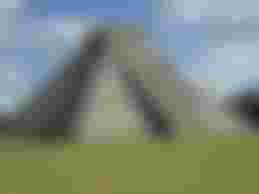The ancient civilizations of the world were all based on a single idea: to survive. The concept, that you could live in a place, where there was no war, disease or starvation. A place where people had enough food and water to be happy and healthy. It's amazing how many ideas we have about what life should be like, but they're all based around survival. And it makes sense! Without survival, there is no happiness. You can have the greatest empire, have enough resources to live in luxury, and still not survive, because it crumble from within.
The ancient civilizations, that have been found by explorers were based around this idea. Several times in history, ships have sailed the world looking for new lands and found them. There's many different types of civilizations, but they have one thing in common: they're all dead. Now, I'm not saying that these civilizations were not capable of great things.
Many of them built huge wonders, that still stand today. They developed amazing technologies, and mastered magic we still use today. Many of these civilizations also created the modern day ideas of government, writing, religion and more. These things may not seem like a big deal now, but in the history of the world, they are massive jumps forward for human kind.
In this article I will talk about the Olmec, the Maya and the Aztec civilizations.
The Olmecs
The first civilization to develop in the area was the Olmecs. They were a group of people, who lived in Mexico and Central America during the Late Pre-Classic period. Their culture is best known for their large stone heads, which they used as totems or religious objects.
These headstones are still found throughout Mesoamerica today. The Olmecs were not only well-known for their monumental heads, but also for their sophisticated architecture. They built pyramid-like structures made of stone, which still stand today. The most famous of these structures is called the Great pyramid of La Venta, which can be seen from afar across the plains of Mexico.

While the Olmecs are known for their stone-based architecture, they did make use of earth as well. We know this from the many circular buildings that have been found. They were built with a solid stone base and adobe (earth) shells, which could be taken down easily and transported. Other than the circular buildings, the Olmec civilization is only known to us through their art. Olmec art tells a story of a nation, that was in contact with the distant Mediterranean World, which suggests that they had trading contacts there.
This is shown by the artwork, that depicts ships and people with various Mediterranean features. Perhaps some of their artists even came from that part of the world. The Olmecs are thought to have been destroyed by a combination of external and internal factors. A number of their major sites remained unexplored and intact until relatively modern times. It was only due to the looting of the rich grave sites, that led to their rediscovery.
The Mayan
Moving on from the Olmecs, the Maya civilization popped up in the area. They too, like the Olmecs, built impressive structures made of stone. These structures were also rectangular and built on solid stone bases, though they tend to be larger. The major difference is, that the Mayan built theirs with wood and stucco. In areas where stone was in short supply, they have also been known to build with mud and wood. Their structures tend to be lesser quality, but still look neat and are easier on the environment. Mayan artwork tends to be more abstract and their structures less "tall", than those of their predecessors.

The only pyramid-like building they tend to build is that of a temple, which are mostly used for religious purposes such as worship. Some of these temples are massive, reaching forty to fifty stories. As with all things, the Maya civilization fell into obscurity and was eventually conquered by a group of more organized people called the Aztecs. Like the Olmecs before them, the Mayan left us with an extensive body of artwork. Perhaps the most impressive of these works of art is their stonework. The precision, detail and quality of the artwork found on the stone buildings left behind is nothing short of amazing.
The Aztecs
The next group, that would play a major role in the future of this land were called the Aztecs. They are most famous for their warfare, which would eventually lead to their downfall. Unlike the other groups mentioned above, they did not build a major empire or structure. What they did was settle in the area and launch a series of attacks on the various places nearby, mainly the Maya and the Olmecs. This eventually lead to them being conquered by the Mayans, who were still around to fight off a number of other invading groups such as the Spanish and the French.
Warfare wasn't the only thing, that the Aztecs were famous for. They were also very religious and built loads of large temples and pyramids dedicated to their Gods. The size and grandeur of these structures were on a massive scale, taking decades or even a whole century to complete. They were intended as temples for the Gods not just for Aztec citizens, but also for the sacrifices, that would take place there.

Human sacrifices were common, as the Gods demanded it in order to keep them pleased. The major contribution, that they made to this land were their written language, the calendar and their writing system. The former allowed for an extensive history to be kept, the latter allowed for complex literature to be created and the third allowed for a system of hieroglyphs, which were picture based writing.
This was a major advance on the cuneiform used by the Sumers and the Phoenicians, but was replaced by the Latin alphabet once the Spanish conquered the Aztecs. It is no wonder, that they were ultimately conquered by the Spanish, who had a far more efficient system of warfare. The Olmecs, the Mayans, the Aztecs and the Spanish are all in the past now.
Modern Day People
The current inhabitants of this land are the modern day people. What are they like? Well, that's a question with a lot of answers. Most of the history of this place is pretty much unknown to the modern world, thanks in part to the Church. When the first explorers from the Old World started finding their settlements, the Church was all too eager to have them killed for their "blasphemy". This was before the days of explorers and sailors, so we don't really have any records of these people, only their spoils.
The Spanish created the most detailed records of the Pre-Spanish civilizations. Most of the books and documents created about them are loaded with propaganda, but they do contain some accurate information. The common people of this land are known as "Hispanics", a term which basically means "Spanish people who don't live in Spain". The term now has a slightly derogatory meaning, which is "Spanish peasant, who is overly patriotic and a little bit retarded" but to be fair, it isn't really that far off.
The Spanish do have a history of raising huge armies of peasants to fight their wars. They also have a history of riding horses, but that's not a big problem in this environment. They tend to be darker skinned, than their 'pale' siblings in Spain (who generally live in bigger cities like Madrid, Barcelona and Sevilla, as well as the Caribbean). They also tend to have more curly or kinky black hair. The curly black hair is generally passed down through the mothers, not the fathers. They also generally have a slightly shorter life span, thanks to the higher amount of violence in the society.
The Hispanics generally live in huge, sprawling cities, which contain as many people as small countries. They also have another trait that one could call an 'inherited flaw': Habsism. That is, they believe that the Spanish people are the only people, who are genuinely 'good' or ' pure '. This can be seen as a good thing or a bad thing, depending on who you are. This is a very new society. They have only been 'modernizing' for about two centuries, and even then it's a pretty recent thing in comparison to other places.
It also means, that they still have a lot of 'traditional' values, which can be good or bad. The most obvious 'good' thing is that they tend to be very resistant to changing things. The system is more or less stuck in a time loop: industrialization, expansion, then regression before expansion again. This has lead to a slightly stagnant society, but one that doesn't change too much. The bad thing is they tend to not learn from their mistakes. Take for instance their attitude towards technology. They have automatic turrets and other weapons, because they remember how the Spanish used to have them and assume, that they are helpful.
Then they have the repeating blunder of making the same mistakes over and over, with the Indians. The Spanish first came to the New World to fight the Aztecs, then stayed to work the gold and silver. While there was always a degree of money issues due to the low population, it didn't really impact too much on the society. However, the huge rise in population and the decline in gold and silver has changed everything. The Indians are no longer a reliable source of supplies for food and materials anymore. The native people of the New World are becoming less and less docile and are declaring war on the Spanish.
The latest thing that's causing problems is the fact, that the land is dying, or rather has been dying for quite some time. To save energy, the cities have been running on minimum power levels. This has had a severe effect on the land. Crops don't grow, trees don't live, air doesn't breath. Basically, it's killing the environment. This has started a mass migration from the cities to the new 'land' that the Church has found. This new land is actually an island, which hasn't had a population for hundreds of years. The island used to be known as 'Jumano' or 'Al-Lam' and was inhabited by a group of hunter-gatherer tribes, who roamed the island in simplicity, not even realizing that the island was an island.
This island has just one natural resource, which is in abundance: people. The Church's goal is to use this resource to create a new world based on the teachings of Christ, but without the rest of the faults of the old one. Humans do not belong in cities, and by sending them to the New World, they will start over as proper, God-fearing peasants. This is going to be good for the human soul. The first group of people to head to the island are the least resourceful. Pregnant women, children and the elderly are all sent off first. Next come people with physical problems or those, who are too young or old to work. The able-bodied are sent off last, because they can work on the farms or in the new mines, that are being set up. This process is very thorough. We're talking blood for blood here. If you are on the island, you are there by the grace of God and not by accident.

Read and learn more about the Maya cicilization here: What The Ancient Maya Civilization Can Teach Us Brief History Of The Maya Civilization
Written by: @NakamotoBch
Lead Image Source: https://commons.m.wikimedia.org/wiki/File:Wikijunior_Ancient_Civlizations_II.png






Im having fun with this. How the ancient civilization raise... Thank you for this peter...